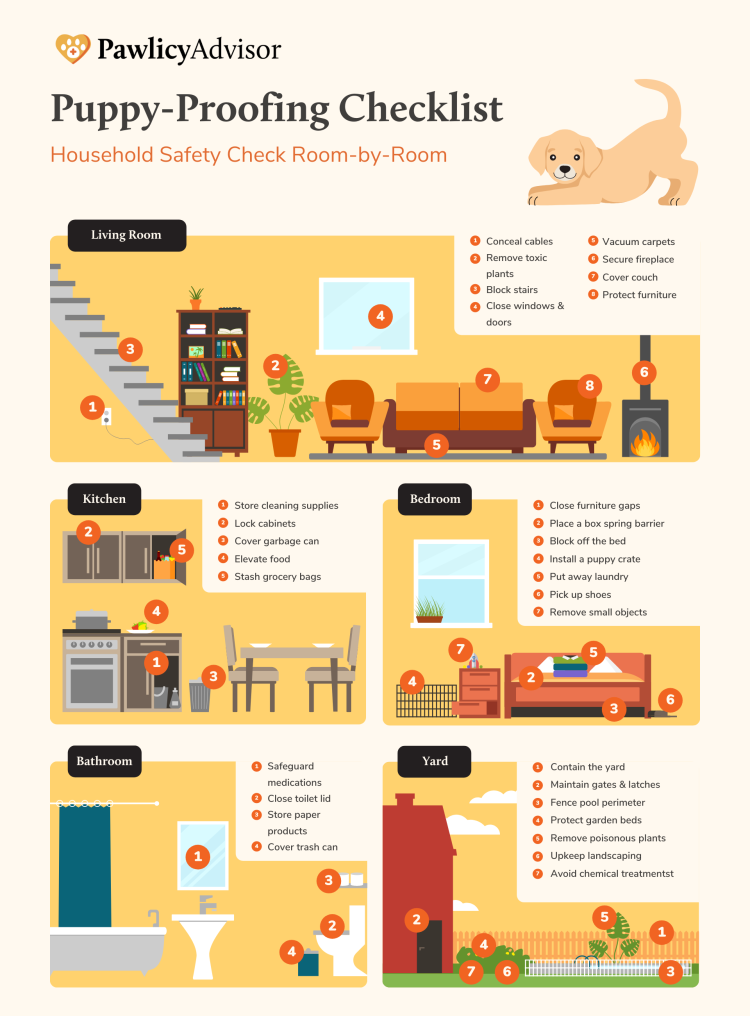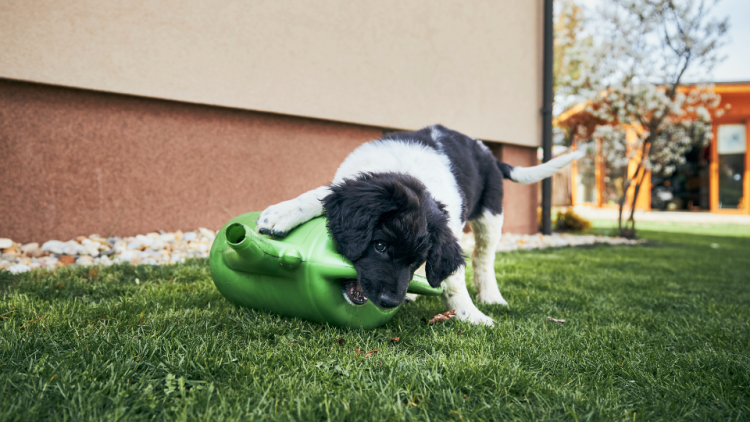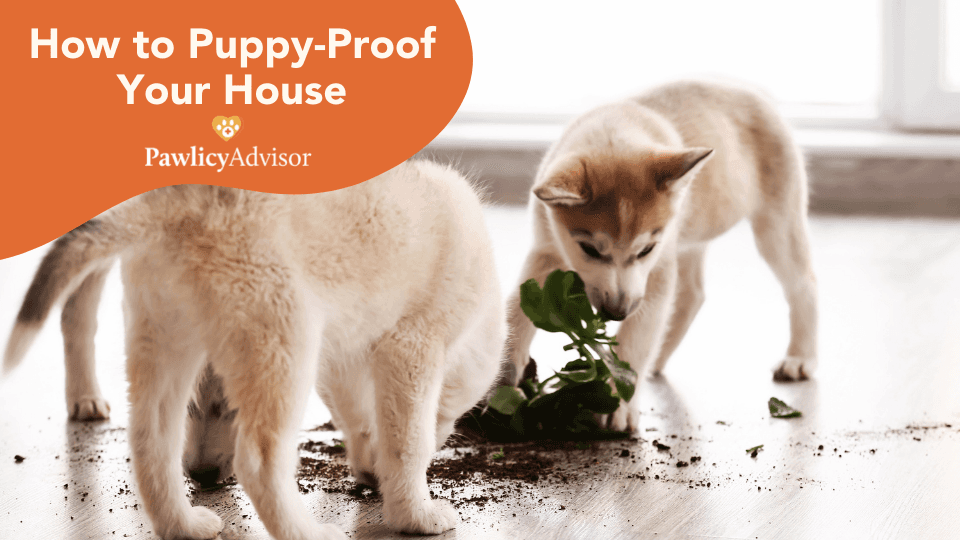If you are a new puppy owner, you are probably already busy finding a good vet and buying all the supplies like collars, leashes, and toys (check out this detailed checklist of puppy supplies to make sure you have everything you need!). But have you also thought about the hazards lurking in your home?
Protect Your Puppy with Pet Insurance
Get the New Puppy Checklist
We've put together a list of tips on how to puppy-proof your house, broken down room by room, to help you make the environment as safe as possible for your four-legged family member.
Here’s what we'll cover on the puppy-proofing checklist:
- What does puppy-proofing your house mean?
- Puppy-Proofing Checklist PDF
- How to puppy-proof the living room
- How to puppy-proof the kitchen
- How to puppy-proof a bedroom
- How to puppy-proof a bathroom
- How to puppy-proof your yard
- Final puppy-proofing tips
What does puppy-proofing your house mean?
Puppy proofing your home means doing a safety check or “four-legged inspection” to catch all the household hazards a curious puppy might encounter. Puppies have a natural inclination to put everything in their mouths, meaning they can easily get into something toxic, choke on a large object, ingest a foreign body, and so on.
Also, when you bring home a new puppy, accidents seem to wait around every corner. Your pet can get suffocate by getting stuck, pinned, or wedged beneath furniture, or they could break a bone by tumbling down the stairs or falling off the couch.
As an owner, it’s your responsibility to do everything you can to take care of your puppy and protect its safety against these potential hazards to reduce the likelihood of them getting hurt.
Puppy-Proofing Checklist PDF

Download the Puppy-Proofing Checklist PDF
How to puppy-proof the living room
Your living room is probably where your new family member will spend the most time, so learning how to puppy-proof the home habitat should be top priority.
Conceal Exposed Cables and Wires
Electrical cords, cables, and wires are a big danger to puppies who tend to gnaw on them while playing. They can cause mouth burns, electrical shock, or even death by electrocution. Be sure to tie up any loose electrical cords and use protective cord covers to keep your puppy from chewing on them.
Remove Toxic Houseplants
Unfortunately, some ordinary houseplants can be toxic to dogs, so you’ll need to be careful with your placement of greenery. The ASPCA’s poisonous plant list is a very helpful guide to plants that are poisonous to pets.
Block Stairs with a Pet Gate
A pet gate is similar to a baby gate as it is used specifically for preventing your puppy from both chewing on the stairs as well as struggling to climb them and potentially tumbling down. Set up the dog gate at the top of the stairs to prevent your puppy from falling. If your puppy wants to climb the stairs, set up an additional pet gate at the bottom.
Close Windows and Doors
If your puppy sees an open door or window, they might interpret it as a sign to run outside and start exploring, so be sure all of them are closed and locked. In addition, tuck away the cords on your blinds to prevent accidental strangulation.
Keep Carpets Vacuumed
Puppies tend to chew everything they can get into their mouth. Keeping your carpets vacuumed is the best way to reduce the risk of your puppy swallowing a small object and choking.
Secure the Fireplace
Keep a screen on your fireplace to ensure that your puppy doesn’t get harmed by the flames or flying sparks. Firestarter logs are another thing to watch for since they can cause poisoning or obstruction in dogs.
Cover the Couch with a Blanket
If your puppy is allowed to join you on the couch, a throw blanket can protect them from tracking any mess onto the upholstery. Just be sure to avoid blankets with fringe or tassels that may entice puppies, and don't leave them on the couch unsupervised if they can't safely jump down yet.
Spray Furniture with Taste Deterrent
Using a deterrent spray is another way to prevent your puppy from chewing on anything they find and potentially choking. As an added bonus, it will keep the surfaces of your home free of dog teeth marks!

How to puppy-proof the kitchen
This kitchen usually poses the most danger to your pet, so it should be high up on your puppy-proofing checklist.
Safely Store Chemicals and Cleaning Supplies
Make sure all cleaning supplies and chemicals are not accessible to your puppy. Dogs explore the world through their mouth, and you certainly don’t want your pet swallowing any of these toxins.
Lock Cabinets and Pantry
If you have cabinets anywhere within your puppy’s reach, secure them with childproof locks. This is especially important if your pantry or cabinets have cleaners or other items that are dangerous for dogs.
Keep the Garbage Covered
If your trash is left open, your puppy could be harmed by swallowing something toxic or choking on a sharp bone. Remove the temptation by keeping all garbage cans securely covered оr keeping garbage in dog-safe trash containers that lock through a pedal mechanism.
Place Human Food Out-of-Reach
Keep human food out of reach at all times. There are many human foods dogs can’t eat because they can be harmful or even toxic to them. These include things that might seem totally harmless, such as apple cores, chocolate, and onions.
Stash Plastic Grocery Bags
Plastic bags are a suffocation risk for puppies, so make sure to put them out of reach as soon as you’re done using them.
How to puppy-proof a bedroom
As you go through the checklist to puppy-proof your house, there are a few safety hazards for puppies commonly found in the bedroom.

Fill Small Gaps Between Furniture
Puppies like to den by wedging themselves in small places and could easily get stuck between a desk and dresser, for example. Consider placing flat storage boxes so there is no space left for your puppy. Fill the boxes to make them heavy and your dog can't push them out of the way.
Place a Barrier Between the Box-Spring Mattress & Floor
Puppy proof under the bed by placing a thin barrier between the box-spring mattress and the floor such as cardboard or foam. This will protect your puppy from any loose springs in case they decide to explore under the bed.
Block Off Under the Bed
Prevent puppies from going under the bed (or couch) by stacking books, cardboard boxes, storage containers, etc. You can also use dog barrier pet blockers. Besides preventing your puppy from going beneath the bed, these will also keep the under-bed space free from dirt and dust.
Get a Puppy-Proof Crate
Teaching your puppy to sleep in a crate can help prevent accidental suffocation overnight. The crate can also serve as a safe, comfortable place for your dog to rest and recharge. Puppies spend 85% of their day sleeping, which is why it’s so important to give them a designated, cozy spot to rest.
Put Laundry in the Hamper
Leaving laundry scattered across your bedroom floor is dangerous because things like socks, buttons, and strings can pose a serious choking hazard to your puppy if ingested. A puppy who eats socks is also at risk of serious complications as a result of an intestinal blockage.
Keep Shoes off the Floor
The earlier you discourage your pet from acquiring bad chewing habits, the better. Keeping shoes, toys, clothes and any other tempting items away from your puppy’s reach will prevent the bad habit from forming and, as a result, reduce the risk of choking.
Be Mindful of Knick Knacks
Veterinarians have seen dogs and puppies eat everything from hair ties and Christmas tree decorations to sewing needles and fish hooks. When these objects are swallowed, it can become a serious and potentially life-threatening problem. Nationwide Pet Insurance reports foreign body ingestion is one of its most common claims, and the average cost to remove a foreign object lodged in the intestine is $2,112.
How to puppy-proof a bathroom
Another room that requires special attention is the bathroom. Puppy-proof your bathroom with the following tips.
Seal and Safeguard Medications
Did you know that the most common reason why pets suffer from poisoning is because they ingested human medication? Nearly 50% of all calls received by Pet Poison Helpline involve human medicine – both prescription and OTC. To prevent a serious tragedy from happening to your puppy, store all of your medications and supplements in a secure drawer or cabinet.
Close Toilet Bowl Lids
Keeping the toilet lid down at all times (or maybe even installing a seat lock) will prevent your pup from ingesting chemical cleaners or even drowning if they fall inside and can’t get back out.
Store Paper Products
Many puppies/dogs like to eat toilet paper. Eating toilet paper can cause an upset stomach, which manifests with diarrhea, vomiting, lethargy, and constipation. Keep toilet paper rolls stored in containers or use roll covers.
Cover the Trash Can
The trash can in the toilet can contain some very dangerous and very unsanitary items, which is why it’s a good idea to cover it or keep it in a cabinet with a child safety lock.
How to puppy-proof your yard
Puppies shouldn't be left outside unsupervised but if you decide to let your puppy play in the backyard or use it for potty breaks, you need to make sure the space is safe and secure. Here are some tips on how to puppy-proof your garden and yard.

Confirm the Yard is Contained
Double-check that there are no holes in the fence and that it’s an appropriate height to prevent your puppy from climbing over it. If your puppy is a digger, consider attaching an L-footer along the bottom of the fence facing in or pouring a concrete footer.
Regularly Maintain Gates and Latches
Ensure that all the latches on fences and gates are secure. If you have a gate that blows open or a latch that doesn’t stay shut, add a hook-and-eye closure or a lock.
Fence the Pool Perimeter
Any pools, hot tubs, and ponds should be covered or fenced off. If you have an above-ground pool, it would be wise to fence the deck steps. If you have an inground pool, fence the pool perimeter completely.
Install Lattice around Garden Beds
Block off the garden area with chicken wire to prevent your puppy from eating dirt or toxic plants but also from making a mess. Chicken wire is flexible and easy to cut. It might not be the most aesthetically pleasing, but it’ll get the job done. If you are looking for something that’s more visually appealing, opt for a prefabricated wooden lattice panel.
Remove Poisonous Plants
Make sure all plants in the yard are pet-safe and remove the ones that aren’t so your puppy can’t eat them. Plants that aren’t toxic to humans, such as Dieffenbachia, those in the Easter lily family, hibiscus, and mistletoe, might cause medical problems in dogs, including cardiac shock, irregular heartbeats, renal failure, and even death.
Pay Attention to Landscaping
Mow your lawn regularly to prevent pests like fleas and ticks from settling in. In addition, when designing your dog-friendly landscaping, ensure that anything you plant is safe for your puppy.
Avoid Chemical Treatments
If your yard has recently been treated with pesticides, insecticides, or fertilizers, be sure to keep your puppy away. If your puppy is exposed to these chemicals, they might exhibit symptoms like vomiting, diarrhea, lethargy, skin irritations, tremors, and even coma and death.
Pick up Poop from Pets and Wildlife
According to AKC, 24% of dogs eat poop from time to time, while about 16% are serial poop eaters. Pet waste carries parasites, bacteria, and viruses that can threaten the health of your puppy, so make it a habit to pick up any poop you spot in your yard and garden.
Final puppy-proofing tips
Puppy proofing isn't all about keeping your four-legged friend safe while at the same time protecting your home from damage. Training a puppy can significantly reduce the need for puppy-proofing the living areas but until then, here are a few final tips to keep in mind:
- Use a playpen when you can’t supervise your puppy. According to one survey, 70% of puppy owners found their playpen or crate to be very helpful in reducing accidents.
- Be prepared for accidents while potty training (they will inevitably happen); odor removers and potty pads will help redirect your puppy from inappropriate behaviors.
- Don’t forget to provide plenty of safe chew toys to satisfy your puppy’s urge while teething, and reinforce good behavior by praising them when they play with the right toys.
- No matter how careful you are, safety hazards will always present a risk. Enroll in a pet insurance policy for peace of mind and know that you are financially prepared for a potential emergency should anything ever happen.
Use Pawlicy Advisor to get personalized recommendations on the best pet insurance plans from leading providers based on your pet's unique information. You can compare coverage details side-by-side to identify which features matter most, then enroll directly online at the lowest possible price, guaranteed.
